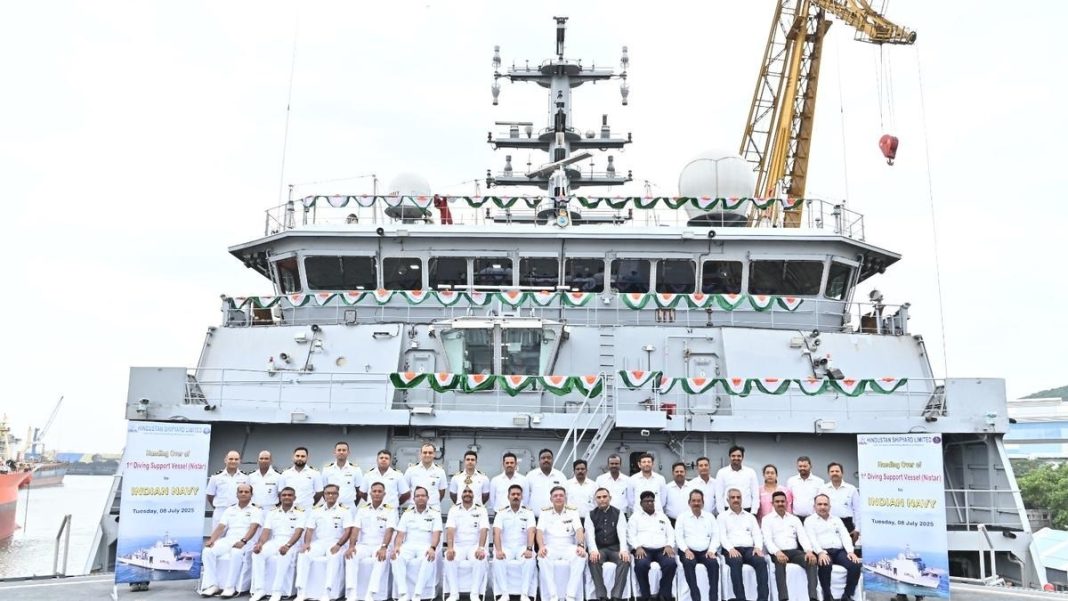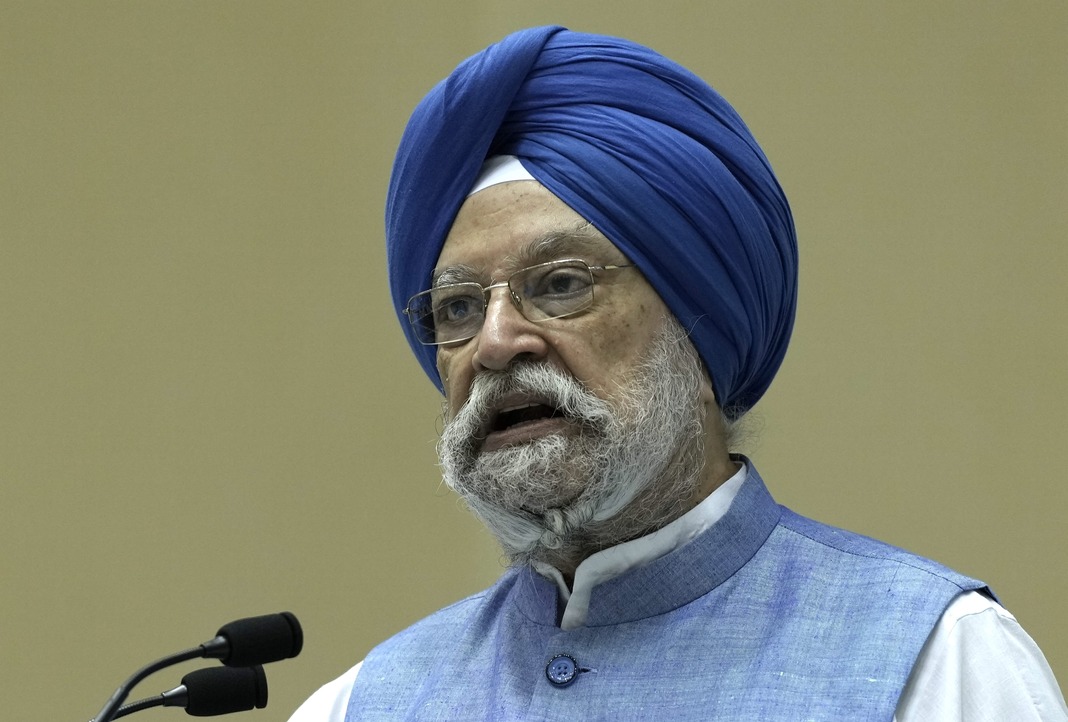By Dipak Kurmi
In a significant leap towards maritime self-reliance and underwater warfare preparedness, the Indian Navy commissioned INS Nistar, a state-of-the-art indigenously designed Diving Support Vessel (DSV), at Visakhapatnam. Built by Hindustan Shipyard Limited (HSL), Nistar represents not merely the next generation of underwater rescue and diving support platforms but a strategic inflection point in India’s maritime ambitions. As the first of two vessels ordered in 2018—the other being INS Nipun, launched in 2022—Nistar stands as a formidable pillar in the Indian Navy’s expanding underwater architecture, aimed at strengthening India’s position as a net security provider in the Indian Ocean Region (IOR).
The original INS Nistar, acquired from the Soviet Union in 1969 and commissioned in 1971, was a vital asset in India’s submarine rescue operations until its decommissioning in 1989. The new Nistar, however, is not merely a revival of that legacy; it is an exponential evolution. With more than 80% indigenous content, this vessel is a landmark achievement under the “Aatmanirbhar Bharat” initiative. Approximately 120 Micro, Small and Medium Enterprises (MSMEs) contributed to its construction, reflecting a maturing domestic defence manufacturing base and the increasing technical sophistication of India’s maritime industry.
Chief of Naval Staff Admiral Dinesh K Tripathi, at the commissioning ceremony, underlined Nistar as a “testimony to the growing capability and maturity of our maritime industrial base,” celebrating it as a potent example of India’s capacity to deliver complex platforms indigenously. Weighing in at around 10,500 tonnes and stretching nearly 120 metres in length, Nistar dwarfs its 800-tonne predecessor and offers a broad spectrum of enhanced capabilities, both operational and strategic.
At the heart of Nistar’s mission is its dual role as a Diving Support Vessel and a Submarine Rescue Ship—a pairing that elevates its utility in both peacetime operations and wartime contingencies. Its onboard systems are engineered for high-precision, deep-sea functions. These include advanced air and saturation diving systems, remotely operated vehicles (ROVs), and side-scan SONARs—all indispensable in modern subsea operations. Crucially, Nistar serves as the mothership for one of India’s two Deep Submergence Rescue Vehicles (DSRVs), acquired from the UK’s M/s James Fisher & Sons in 2018 and 2019. The sister DSRV is attached to INS Nipun, which will be stationed on the western seaboard once commissioned.
The DSRVs mark India’s entry into an elite club of only 12 nations possessing dedicated submarine rescue capabilities. These specialised vehicles can be airlifted and deployed internationally, enabling India to assist other nations during underwater emergencies. This portability, coupled with India’s operational readiness and dual-coast deployment model, gives the Navy unparalleled flexibility in maritime humanitarian assistance and disaster relief (HADR) operations—both within and beyond the IOR.
Prior to Nistar’s induction, the Indian Navy relied on commercially leased platforms for deploying its DSRVs, a significant limitation that restricted its capacity for instant response and round-the-clock readiness. The integration of Nistar into the Navy’s fleet marks a definitive shift in this regard. It allows the Indian Navy to maintain permanent, high-alert rescue preparedness across both coasts. While Nistar will operate from Visakhapatnam on the Eastern Seaboard, Nipun will cover the Western Seaboard from Mumbai, collectively forming a robust national submarine rescue grid.
Technologically, Nistar is also a marvel of subsea engineering. The vessel features a dynamic positioning system, enabling it to remain stationary even in challenging maritime conditions—critical when operating rescue vehicles at great depths. It also houses a 15-tonne subsea crane, a helipad for aerial support, and a fully functional medical complex comprising an operating theatre, intensive care unit, and a hyperbaric chamber-equipped eight-bedded hospital. These medical facilities are indispensable not only for treating divers and submariners suffering from decompression sickness or other critical conditions but also for broader HADR missions.
Endurance is another of Nistar’s vital strengths. With a sea endurance of over 60 days, it can undertake prolonged missions in remote or contested maritime theatres. This extended operational reach amplifies India’s capacity for sustained presence and immediate intervention in case of submarine mishaps—a pressing necessity as India continues to expand its submarine fleet.
The timing of Nistar’s commissioning is strategic. The Indian Navy is steadily augmenting its underwater capabilities through the induction of conventional and nuclear-powered submarines. However, an increase in such assets proportionally raises the risk quotient, especially in the high-pressure, low-visibility realm of deep-sea operations. Modern naval doctrines necessitate that every submarine deployment be backed by reliable and immediate rescue capabilities. Nistar and Nipun fulfill this doctrinal gap, offering the Indian Navy an unmatched capability to rapidly locate and extract distressed submariners, potentially saving dozens of lives during accidents.
On the geopolitical plane, Nistar is equally consequential. India’s emergence as a key maritime player in the Indo-Pacific hinges not only on offensive capabilities but also on its ability to provide public goods—such as search and rescue, anti-piracy, and HADR. The strategic projection of Nistar as a platform capable of international submarine rescue assistance contributes to India’s soft power and reinforces its image as a responsible regional power. By extending the possibility of cooperative rescue operations through bilateral arrangements and memorandums of understanding (MoUs), India positions itself as a first responder in subsea contingencies, enhancing interoperability with friendly navies.
This development is particularly relevant given increasing maritime tensions in Asia, whether in the South China Sea, Bay of Bengal, or even the western Indian Ocean, where critical shipping lanes traverse volatile zones. In such an environment, a credible submarine rescue capability is not just an operational asset—it is a strategic necessity.
Moreover, Nistar’s induction coincides with India’s larger efforts to modernise its naval fleet through indigenous development. From aircraft carriers like INS Vikrant to stealth destroyers of the Project 15B class and now to Nistar, the focus has clearly shifted towards achieving technological autonomy in key maritime domains. In this context, Nistar is more than just a rescue platform; it is an emblem of India’s resolve to secure its maritime interests through self-reliant, homegrown innovation.
With India’s maritime footprint expanding from the Strait of Malacca to the coast of Africa, the role of versatile platforms like Nistar will become increasingly vital. Not only can such vessels be rapidly deployed for search and rescue in hostile or inaccessible environments, but their endurance and modularity make them ideal for prolonged surveillance and assistance missions, even under peacetime conditions.
To be sure, the path ahead involves maintaining high operational readiness, training submarine crews and DSRV operators under simulated emergency conditions, and ensuring robust interoperability with allied navies. But with the commissioning of INS Nistar, India has taken a giant stride toward consolidating its undersea dominance—not just in terms of deterrence and warfare, but in humanitarian leadership, technological innovation, and maritime responsibility.
In a world where the oceans are theatres of both conflict and cooperation, and where the line between competition and catastrophe can blur in an instant, INS Nistar offers India a tool of rare and enduring value. It is a vessel that rescues lives, upholds international commitments, and furthers India’s aspiration to be not only a regional force but a global maritime conscience.
(the writer can be reached at dipakkurmiglpltd@gmail.com)




